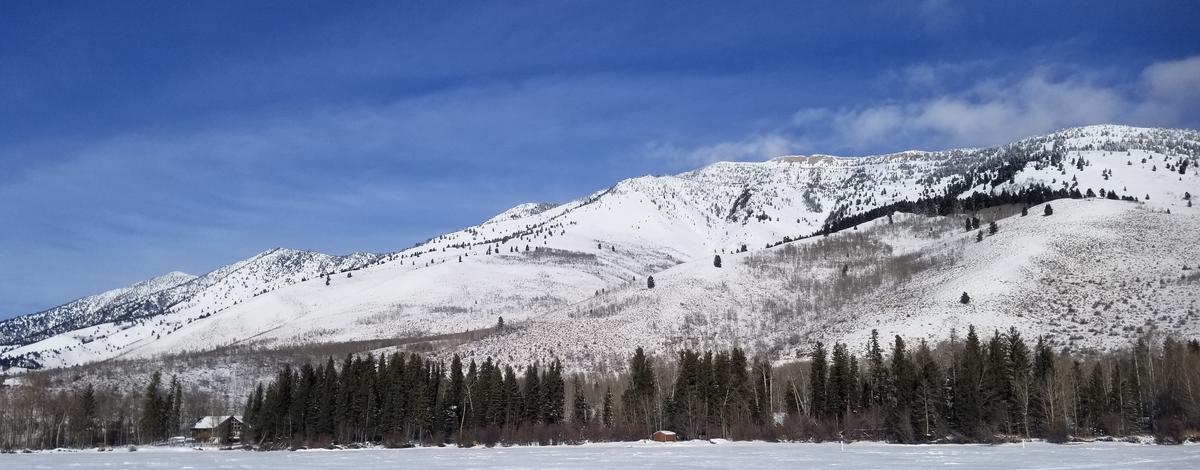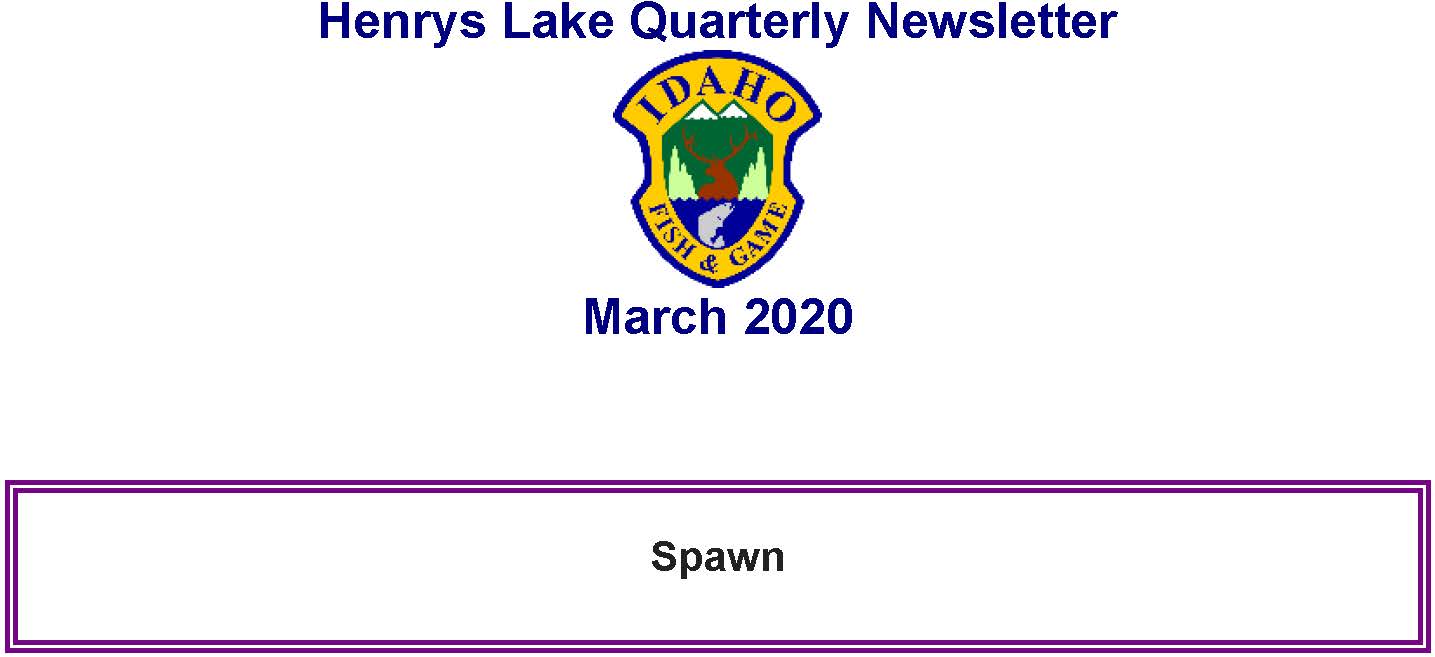
Each year the Idaho Department of Fish and Game (IDFG) spawn Yellowstone cutthroat trout (YCT) at the Henrys Lake Fisheries Management Station. More than 10,000 trout entered our spawn shed during the month of February, while thousands more were still staging in the lake getting ready to move upstream. Over the span of nine spawn days we generated 770,000 sterile hybrid trout (female YCT x male rainbow trout) and 2.8 million Yellowstone cutthroat trout fertilized eggs. Eggs are currently being incubated on site following fertilization for approximately 28 days. Once these eggs have reached their "eyed" egg stage, which is the stage in development when a distinct eye spot is visible in the egg, they are sorted to remove any impurities or unfertilized eggs and enumerated.
Next, the hybrid eggs are transported to the American Falls Fish Hatchery, and the YCT eggs are transported to the Mackay Fish Hatchery. These eggs will incubate, hatch, and be raised to fingerling trout before being stocked back into Henrys Lake in June (hybrids) and September (YCT) 2020.

Sterile hybrid trout are created on site each year. To create our sterile hybrid trout, IDFG staff at the Hayspur Fish Hatchery rise at the crack of dawn and express milt from rainbow trout on site. Milt from each individual male is bagged, placed on ice and driven just over three and a half hours to our staff at Henrys Lake. Once on site, we collect eggs from Henrys Lake Yellowstone cutthroat trout and fertilize them with the rainbow trout milt provided by the Hayspur Fish Hatchery. Following a specific formula for time after fertilization, these eggs then undergo a pressure-shock treatment. By subjecting these eggs to high amounts of pressure we are able to interrupt cell division and create what is referred to as a triploid fish which are unable to reproduce successfully. By stocking the lake with sterile hybrid trout we can provide anglers with the opportunity to catch some trophy trout and multiple trout species in the lake while protecting our native Yellowstone cutthroat trout genetics and spawning habitat.


Each winter we track the amount of oxygen available under the ice of Henrys Lake. The amount of oxygen in the water is crucial to the health and survival of trout. When oxygen levels decline below 2.3 g/m2, fish become stressed and their bodies are unable to perform to their full potential. Thus, the more oxygen available in the water column the better it is for the fish. To track oxygen levels, we measure dissolved oxygen concentrations throughout the water column at multiple locations on the lake. Below you can see our oxygen depletion estimates for the 2018-2019 and 2019-2020 winters.
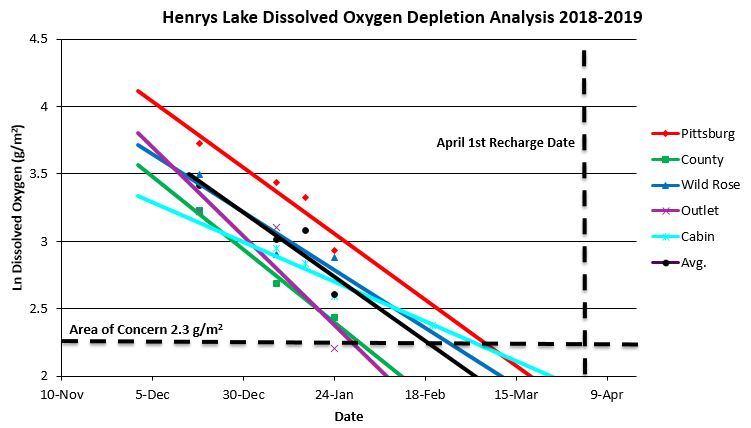
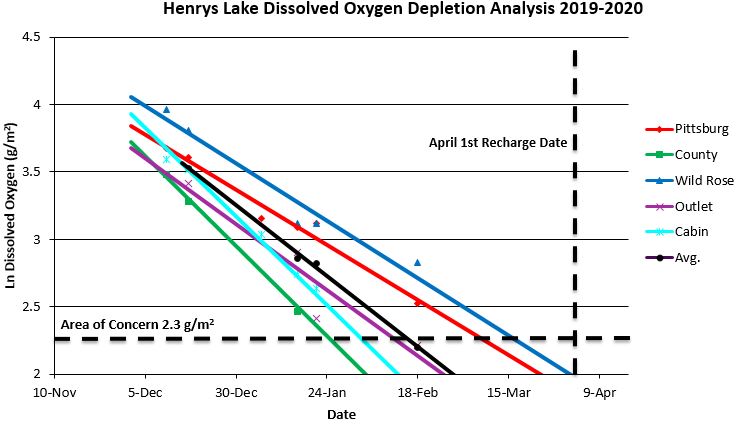
One major distinction between these two winters is the amount of time that ice has covered the lake. In 2018, the lake was not fully encompassed by ice until mid-November while the lake was completely covered by ice just before Halloween in 2019 (Oct. 29th). That's an additional three weeks of ice covering the lake in 2019 and this is noticeable in the depletion rates indicated above.
The graph below shows the dissolved oxygen depletion estimates for the average of all five sampling locations over the last five winters. The current trend for 2019-2020 indicates slightly lower dissolved oxygen under the ice when compared to the previous two seasons. This again may be a factor of increased ice-on time.


Every three years our staff conduct interviews with anglers and gather information throughout the entire fishing season on Henrys Lake. These interviews provide us with valuable information on the current state of the fishery. We conducted 920 individual interviews between May 25, 2019 and Jan. 1, 2020. Of these anglers, 75% were Idaho residents and 24% were nonresidents.
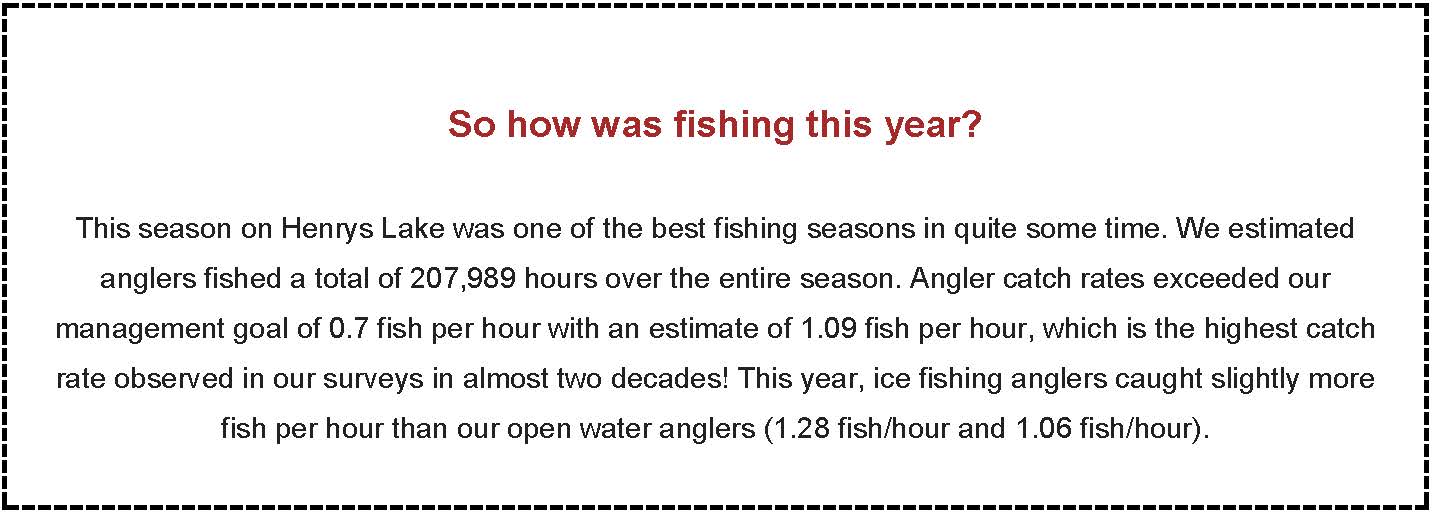
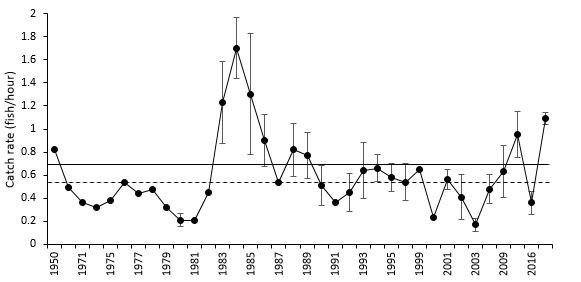
Angler catch rates (fish per hour) with 95% confidence intervals from 1950 to 2019 on Henrys Lake, Idaho. Dotted and dashed lines represent the long-term average and management target (0.7 fish per hour), respectively.
We estimate that anglers caught a total of 227,490 trout this season with 183,484 and 44,006 trout caught during the open water and ice fisheries respectively. Species composition of angler catch was 45% Hybrid Trout, 39% Yellowstone Cutthroat Trout, and 15% Brook Trout. Of the 227,490 trout caught, anglers harvested a total of 33,109 fish indicating that 85% of the fish caught this season were released back into Henrys Lake.
Of the trout measured by our creel clerks, 16% of the Brook Trout were larger than 450 mm (~18 inches), 25% of the Hybrid Trout and 20% of the Yellowstone Cutthroat Trout were larger than 500 mm (~20 inches). A large number of Age-2 fish were caught during both the open water and ice fisheries which points to the possibility of some great fishing opportunities in the future.
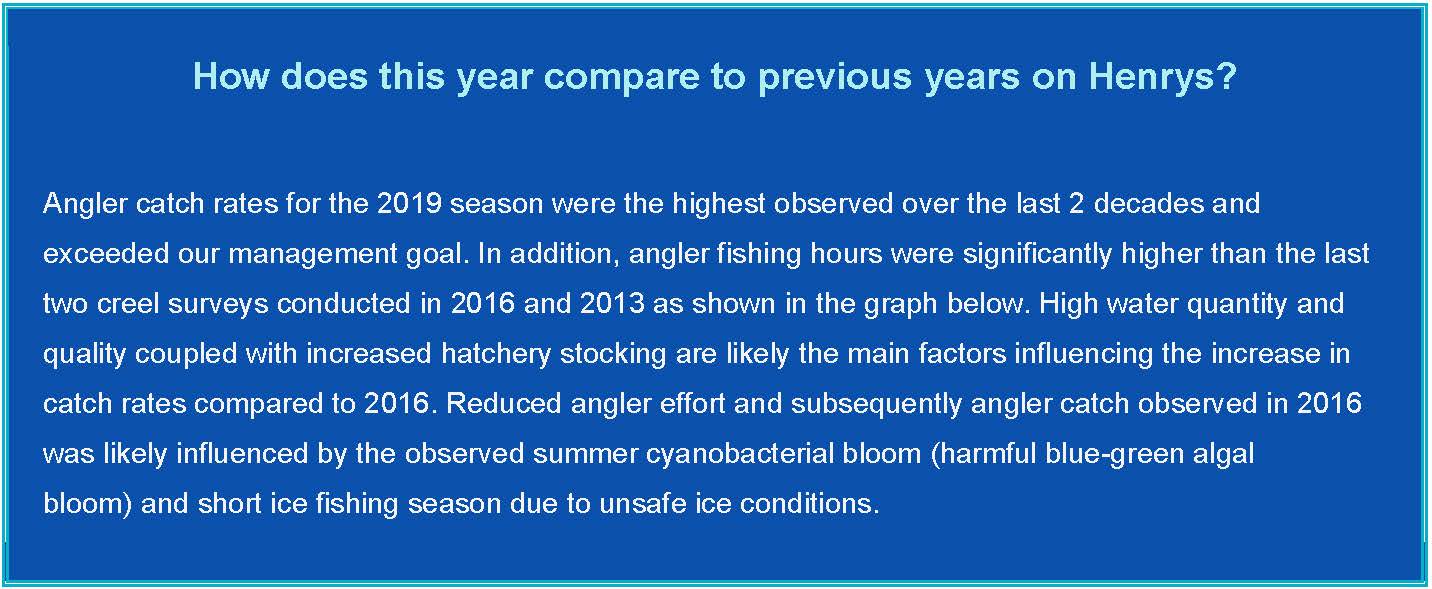
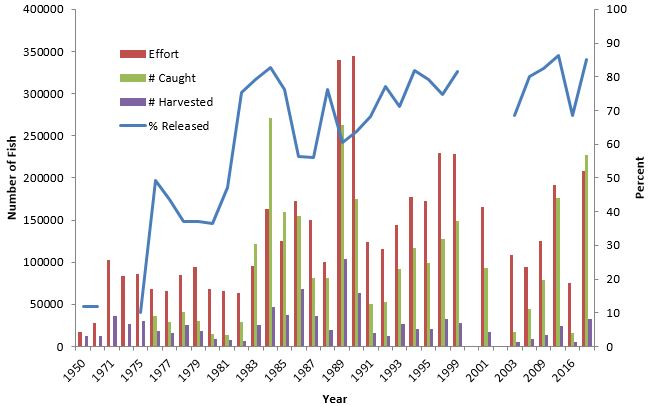

Over the last few years we have been collecting tissue from native and hatchery trout in Henrys Lake. With this tissue, we can essentially fingerprint each individual fish, trace their lineage, and determine who the parents were (wild or hatchery stocked). This project replaces our adipose-fin clipping project that we have used in the past to estimate wild vs. hatchery contributions to Henrys Lake. Prior to 2017, we fin clipped 10% of all the hatchery fish stocked into Henrys Lake. Now we can genetically tag every hatchery fish stocked back into the lake. This is a significant leap forward and will allow us to answer many management questions we have had for decades. Currently, we are focusing on quantifying the amount of wild production that occurs in the lake.
Genetic records have been obtained from the 2017, 2018, 2019, and 2020 Yellowstone cutthroat trout (YCT) brood stock spawned at the Henrys Lake Fisheries Management Station. Since we have genetic records of all of the hatchery fish parents, we will know if a fish sampled from the lake is of wild origin if we are unable to match its genetics back to a hatchery parent.
Our current estimates indicate that the wild YCT contribution to Henrys Lake was 1.6% for 2017 and 1.5% for 2018. This spring and summer we will continue to collect genetic samples from juvenile YCT in the lake and tributaries to estimate the natural production for 2019. Understanding the wild contribution of YCT in the lake will allow IDFG to make more informed decisions on fisheries management and what kinds of projects are needed to make fishing even better at Henrys Lake.


1. Gillnetting: Our annual gillnet survey takes place just after ice-off (April/May). Information gathered from this survey allows us to monitor trends in abundance, size and age classes of trout and Utah chub in Henrys Lake.
2. Graduate student project: We have partnered with the University of Idaho to help the department better understand interactions between Yellowstone cutthroat trout and Utah chub. This year marks the second field season for Darcy, our graduate student, and she will be back on the lake from spring through fall conducting research. For more information on this project, take a look at our December 2019 version of this newsletter. https://mailchi.mp/01cdd8843410/henrys-lake-newsletter-december-2019
3. Henrys Lake tributary habitat projects: Each year we install and maintain miles of electric and jack fences along the tributaries of Henrys Lake to help protect and rehabilitate riparian areas. This spring, we will also be putting some finishing touches on two diversion structures installed in Rock Creek last fall. These diversions were installed through a collaboration with the U.S. Forest Service, Henrys Lake Foundation, and multiple landowners. Our aim is to keep more water in the stream by helping landowners more precisely control how much water is diverted to their properties for irrigation.
4. Fry trapping: During spring and summer 2020, we will be trapping out-migrating fry in the tributaries of Henrys Lake. A genetic fin clip will be taken from all Yellowstone cutthroat trout encountered and compared to our hatchery parent genetics. This will allow us to estimate the wild contribution of YCT to Henrys Lake in 2020.
Ask a Biologist
At the end of each newsletter we will have a section addressing any questions you may have. Please send your questions to jenn.vincent@idfg.idaho.gov
A: Fishing Regulations vary by the time of the year and location. Please remember to check all fishing regulations before venturing out to any bodies of water. Idaho Fishing Regulations books are free and can be picked up at multiple venders, IDFG offices, Henrys Lake State Park and the Henrys Lake Hatchery parking lot kiosk.
There are two portions of the lake which are closed to fishing year round. Both of these locations are outlined by buoys and are 100 yards from the mouth of Hatchery Creek and Staley Springs.
• January 2 through to the Friday before Memorial Day weekend
o Closed to fishing.
• Saturday of Memorial Day weekend through to midnight on January 1st
o Open to fishing.
o Trout limit is 2. This trout limit includes Yellowstone Cutthroat Trout, Hybrid Trout and Brook Trout.
o Fishing may not continue after 2 trout have been reduced to possession.
Henrys Lake Outlet
• December 1 through Friday before Memorial Day weekend
o Trout limit is 0.
o Catch and release only.
• Saturday of Memorial Day weekend through November 30
o Trout limit is 6, only 2 may be Cutthroat Trout, no Cutthroat Trout under 16 inches.
Henrys Lake Tributaries
• April 1 through June 30
o Closed to fishing.
• July 1 through March 31
o No harvest of Cutthroat Trout.
o Brook Trout limit is 25, only 2 Brook Trout over 16 inches.
• Hatchery Creek
o Closed to fishing.
Fishing Regulations
Our next quarterly newsletter will be sent out in June 2020 so stay tuned!
If you have any questions, thoughts or concerns please contact the Henrys Lake Biologist Jenn Vincent at jenn.vincent@idfg.idaho.gov

